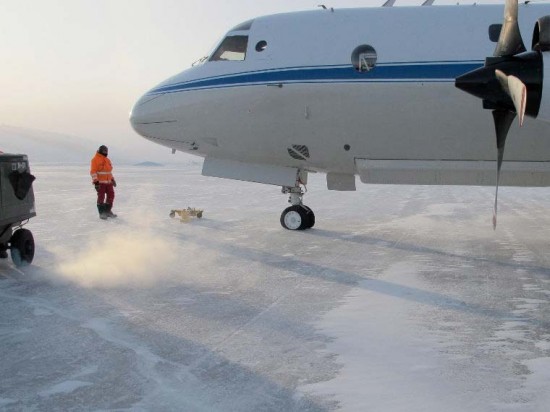In an attempt to survey the landscape of Antarctica and the Arctic, NASA works with networking constraints similar to those of the Curiosity rover, keeping in touch with the ground crew at worse-than-dial-up speeds using the lowest-bandwidth method possible: Internet Relay Chat.
Yes, IRC. NASA launched Operation Ice Bridge to conduct aerial surveys between 2010 and 2015. The previous method of using a laser sensor began failing, and the new laser won’t be operational until 2015, hence the need for Operation IceBridge.
Flying 500 meters above the surface in a precisely-planned pattern over the Antarctic ice sheets, the OIB aircraft carries ice-penetrating radar, a gravimeter for measuring variations in the density of the ice below, and laser altimeter that combines GPS data with laser measurements to build a precise record of the elevation of the ice sheets.
Because of the poor satellite coverage in the Antarctic, the refitted vintage Douglas DC-8 airliner can’t use the Inmarsat BGAN service it normally uses for voice and data communication channels. It’s not practical for OIB’s flying laboratory and other science on the move to try to lock in on TDRS or GOES-3; the only real option is to use the Iridium satellite network, which is pretty much the equivalent of dial-up.
Iridium’s 66 low-orbit satellites zip around Earth in near-polar orbits. Since they orbit at just 470 miles or so above the Earth, they don’t require directional antennas or the kind of broadcast power needed for most satellite communications. Unfortunately this means he satellites quickly pass in and out of range, and connections have to be passed off from one to the other.
Operation Ice Bridge squeezes all it can out of Iridium the old-fashioned way—by multiplexing over PPP Multilink. By aggregating the connections, the OIB flying lab gets about 9600 bits per second of bandwidth. Over that BBS-worthy bandwidth, Operation Ice Bridge pushes and pulls three main types of data. One of them is IRC chat, which allowed for the crew on the DC-8 to coordinate with the ground crew in Punta Areas, Chile, and has also been used during the summer to coordinate with weather forecasters for thunderstorm-chasing over Kansas.
he DC-8 also sends back an ASCII-based telemetry stream over the Iridium connection, providing the aircraft’s location as well as some meteorological sensor data. Another stream of data that comes over the multiplexed Iridium channels is a feed of weather and satellite data from the ground station. Certain missions flown by NASA’s Earth Science Division have changed their flight plans in mid-air based on updated satellite data.











